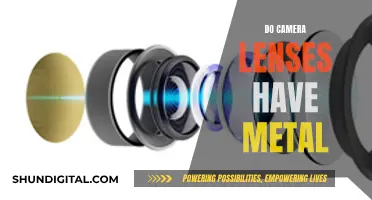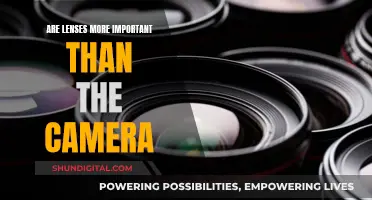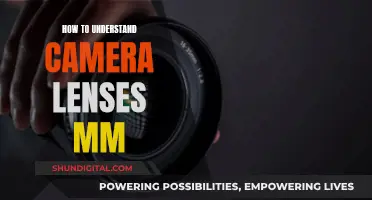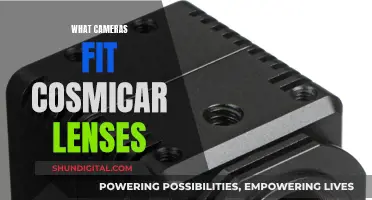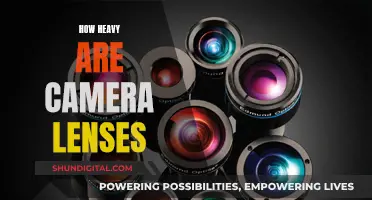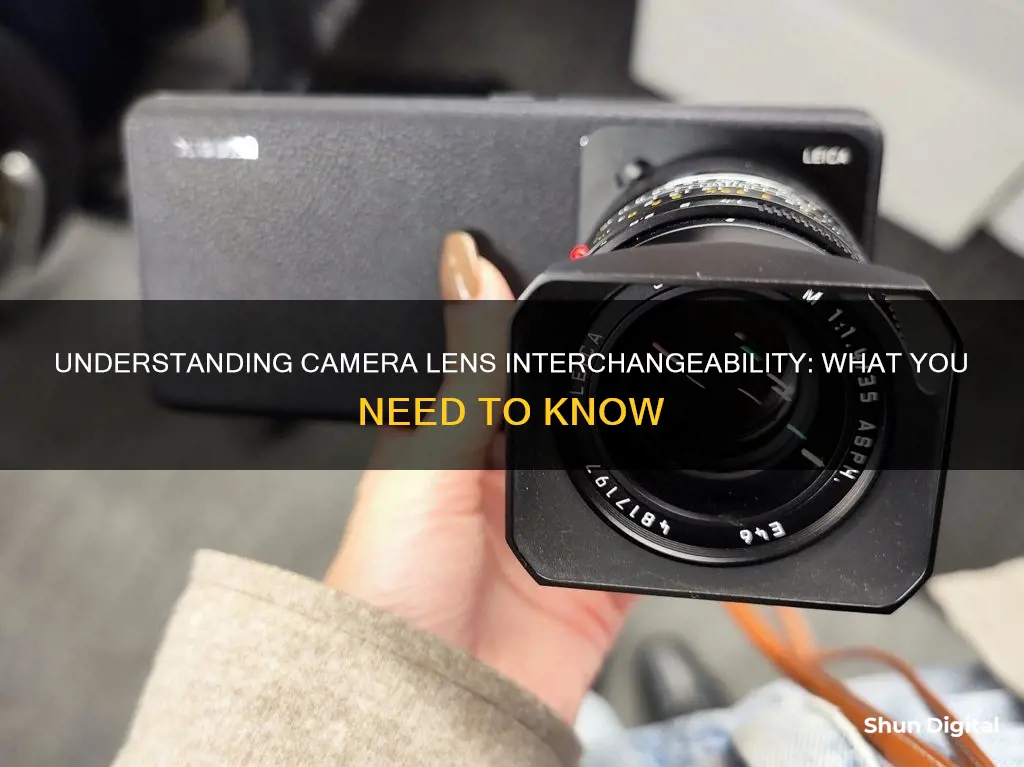
Camera lenses are not universal. While lenses are interchangeable – in that a camera can use different kinds of lenses (standard, wide angle, macro, etc), they aren’t completely interchangeable across brands and types of cameras. The junction where your camera meets the lens is called the mount, and every major company uses its own proprietary mount. So, if you want to use a lens on your Canon camera, you’ll have to buy a Canon lens or a lens from a third-party company that makes models in that specific mount.
| Characteristics | Values |
|---|---|
| Variety of lenses | Standard, wide angle, macro, telephoto, prime, fisheye, tilt-shift, etc. |
| Interchangeability | Lenses are interchangeable within their specific camera brand and model |
| Lens manufacturers | Canon, Nikon, Sigma, Tamron, Tokina, Sony, Pentax, Fujifilm, Panasonic, Olympus, Leica, Kodak |
| Lens mounts | EF, RF, F, SL, K, EF-S, Z, E, X, L, Micro Four Thirds, S, GFX, Pentax 645 A, M, OM |
| Lens features | Focal length, optical characteristics, mount type, image stabilisation, aperture, autofocus, image quality |
What You'll Learn
- Lenses are not completely interchangeable across brands and types of cameras
- Canon cameras have four mount types
- DSLR lenses are not compatible with mirrorless cameras
- Sensor size affects your lens options
- There are six lens categories: standard/regular zoom, telephoto zoom, wide angle, macro, prime, and specialty

Lenses are not completely interchangeable across brands and types of cameras
Different camera models within a brand can also have different lens mounts, so knowing the brand is not always enough to determine compatibility. For example, Canon has four types of lens mounts for its various camera models. The Canon EF-lens mount, introduced in 1987, was designed for the EOS range of cameras, while the newer EF-S-mount, introduced in 2003, is used for cameras with APS-C sensors.
The type of camera you have will also determine which lenses are compatible. Digital Single-Lens Reflex (DSLR) cameras, for instance, have their own set of compatible lenses that won't fit other types of cameras. Mirrorless cameras, which are a more recent development, have different lens requirements and are not compatible with DSLR lenses without an adapter.
Sensor size is another factor that affects lens compatibility. Full-frame lenses will work on cameras with smaller sensors, but the image will appear zoomed-in compared to a full-frame camera. This is because the smaller sensor captures a smaller portion of the lens's image circle.
Lens and Camera Compatibility: Universal Fit or Not?
You may want to see also

Canon cameras have four mount types
- EOS APS-C R System or EOS Full-frame R System mirrorless: This type of Canon camera has a red line on the lens mount.
- EOS APS-C DSLR: This type of Canon camera has a red circle and a white square on the lens mount.
- EOS full-frame DSLR: This type of Canon camera has only a red circle on the lens mount.
- EOS M series APS-C mirrorless: This type of Canon camera has a white circle on the lens mount.
It's important to note that not all lenses are interchangeable with any camera. For example, Canon lenses are designed to work with Canon cameras and are not compatible with Nikon or Sony cameras. While third-party mounting adapters are available, they may not allow the use of all features.
Canon has produced a range of lenses that are compatible with different camera bodies, depending on the lens mount. The EF-EOS R Adapter, for instance, allows EF, EF-S, TS-E, and MP-E lenses to be used on EOS R System cameras.
The type of lens mount on your camera will determine which lenses are compatible, so it's important to check the mount type before purchasing new lenses.
Protect Your Camera Lens: Storage Tips for Photographers
You may want to see also

DSLR lenses are not compatible with mirrorless cameras
While it is possible to adapt DSLR lenses to a mirrorless camera, it is difficult and often impossible to do the reverse. For example, Canon shooters can use an adapter to put their older EF lenses (intended for DSLRs) onto its R-series mirrorless bodies without a significant penalty in performance. However, trying to put a native mirrorless RF lens on a DSLR is impossible, and even if it could be mounted, its proximity to the sensor would limit the range in which it could focus.
There are also other considerations when using adapters to attach DSLR lenses to a mirrorless camera. Automatic features such as focus and VR may not work as reliably as they did on the original camera, and you may be restricted to certain exposure modes and features. The lenses may also be bulkier than the camera, and not all older lenses perform well on newer digital cameras, particularly wide-angle lenses.
Therefore, while it is technically possible to use DSLR lenses on a mirrorless camera with an adapter, the limitations and potential performance issues make it impractical for most users.
Cleaning Camera Lenses: A Step-by-Step Guide
You may want to see also

Sensor size affects your lens options
The sensor size of a camera affects the lenses that can be used with it. A larger sensor will require a larger lens to cast an image over it. This means that the camera body will also have to be larger to house the sensor.
The sensor size also affects the image quality and resolution. A larger sensor will have larger photosites, which will be able to hold more megapixels, creating a clearer image. A larger sensor will also be able to capture more light, which will result in better low-light performance.
The size of the sensor will also determine the angle of view. Smaller sensors will have a crop factor, meaning that they will capture less of the scene than a larger sensor.
The High Cost of Camera Lenses: Why So Expensive?
You may want to see also

There are six lens categories: standard/regular zoom, telephoto zoom, wide angle, macro, prime, and specialty
Camera lenses are not universally interchangeable. Canon lenses, for example, are designed to work with Canon cameras, and not Nikon or Sony. However, third-party mounting adapters are available, and third-party lens makers such as Sigma, Tamron, and Tokina produce optics for a wide range of camera models.
Standard/Regular Zoom Lenses
The kit lens that comes with a camera is most likely a standard or regular zoom lens, with a focal length range of 18-55mm or 28-70mm. These lenses are versatile and allow you to zoom in and out without changing lenses. However, they often have variable apertures, which can make it difficult to get the right exposure in low light or challenging lighting conditions. Upgrading to a standard zoom lens with a constant f/2.8 aperture can offer a significant improvement in photo quality, especially when zooming.
Telephoto Zoom Lenses
Telephoto zoom lenses have a much longer focal length than standard zoom lenses, typically ranging from 70-300mm. They are useful for getting close-up shots of distant subjects, such as in nature or sports photography. While telephoto zoom lenses offer the convenience of variable focal lengths, they tend to be heavier and more expensive, especially if you want a fast lens with a wide aperture.
Wide-Angle Lenses
Wide-angle lenses offer a maximum field of view, with focal lengths usually between 10-24mm. They are great for capturing scenic views and are particularly useful for indoor photography when you want to include a lot in your frame but can't physically back up. Keep in mind that wide-angle lenses on cameras with APS-C sensors will result in a cropped image, reducing the effective field of view.
Macro Lenses
Macro lenses allow you to get extremely close to your subject, capturing tiny details that would otherwise be impossible to see. They are available in fixed focal lengths and are popular for photographing insects, flowers, and other small objects. Macro lenses are also excellent for portrait photography, as they can create a shallow depth of field and beautiful bokeh.
Prime Lenses
Prime lenses have fixed focal lengths and do not have zooming capabilities. This means you need to physically reposition yourself to recompose your photos. While this may seem like a limitation, prime lenses are generally regarded as offering the highest image quality, with faster apertures that perform well in low light and produce stunning background blur. Common prime lenses include 50mm, 35mm, and 85mm.
Specialty Lenses
Specialty lenses include fisheye and tilt-shift lenses. Fisheye lenses create a highly distorted circular image with an ultra-wide field of view, while tilt-shift lenses offer unique features like selective focus, allowing you to choose a specific part of the image to keep in focus. These lenses are often used for "miniature faking," making life-sized scenes appear like miniature models.
Universal Camera Lenses: A Myth or Reality?
You may want to see also
Frequently asked questions
Yes, camera lenses are interchangeable, but only within certain brands and types of cameras.
Yes, it's likely that only lenses from the same brand will fit your camera. For example, a Canon lens won't fit a Nikon camera.
You may be able to use a third-party lens made by a company such as Sigma, Tamron, or Tokina, but you'll need to check that it's compatible with your camera's mount and sensor size.
The lens mount is the junction where your camera meets the lens. Each camera brand uses its own proprietary mount, so it's important to check that a lens is compatible with your camera's mount before purchasing.
You can check the lens mount index on the front of your camera. For example, Canon cameras have four mount types, which can be identified by looking for a red line, a red circle and a white square, a red circle, or a white circle on the lens mount.


